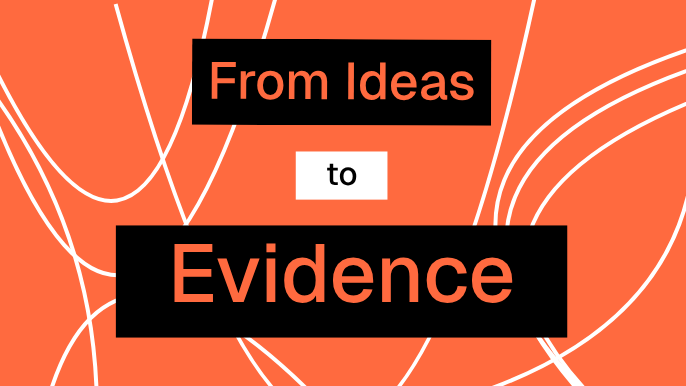From ideas to evidence: building an Innovation Engine in a regulated enterprise


What happens when you try to build an innovation engine inside a company that's allergic to failure?
For 18 months, I worked with a team inside a multi-billion-dollar regulated enterprise, the kind of place where "let's just try it" isn't an option, where Legal and Risk have veto power, and where one bad experiment could end up in the media or in front of a regulator.
We built something that worked. And it changed how hundreds of people think about innovation.
Here's how we did it.
The beginning: the Head of Innovation was out of control
I'll be honest—when I first met the Head of Innovation, I was skeptical.
He'd been at the company for nearly a decade. He knew everyone. He had strong opinions about everything. And he moved fast, the kind of fast that ships features without asking if anyone actually wants them.
Leadership wanted him to lead the new innovation function. I thought they were setting him up to fail.
But the Head of Innovation surprised me.
Instead of defending his ideas or rushing to build things, he leaned into the discomfort of slowing down. He asked uncomfortable questions. He challenged his own assumptions. And he did something I rarely see in enterprise: he admitted when he was wrong.
That openness—that willingness to be wrong—is what made everything else possible.
The unsexy first step: permission
Most innovation programs start with workshops and whiteboards and post-it notes. We started with Legal and Risk.
The Head of Innovation spent the first few weeks co-designing a way of working with the head of legal. They built a framework for running live experiments with real customers in a highly regulated environment—something the company had never done before.
This wasn't glamorous work. It was meetings about compliance. It was defining safe boundaries. It was figuring out what "safe to fail" actually meant when you're in gaming and entertainment.
But this boring, unglamorous work was the foundation for everything that came after. Because once we had permission, we had speed.
The first win: proving we could test at all
The first experiment wasn't about the result. It was about proving we could run an experiment in production without breaking anything.
We picked a low-risk area in retail, a space that had been ignored for years. We designed a simple test. We got it live.
And when nothing exploded, when Legal didn't shut us down, when Risk didn't panic, that was the win.
The metric wasn't the metric. The win was proving it was possible.
QR codes: the thing everyone said was a waste of time
Early on, the innovation team started experimenting with QR codes in retail venues.
Leadership was skeptical. "Why are you wasting time on this? It's too small. Focus on something that matters."
But the team kept going. They tested different placements. Different messaging. Different offers. They failed. A lot.
And then something clicked.
Those retail screens that everyone had written off as "noise"? They became conversion channels. Real, measurable conversion that could be tracked and optimized. The QR codes that started as a "silly little experiment" became the backbone of event-driven promotions, including a Melbourne Cup activation that drove significant revenue.
"Traditionally, our screens had been pseudo marketing screens and had just become noise. We were able to turn them, through testing in the right spaces, into conversion channels that drove a measurable outcome in a way that no one had been able to do before."
— Head of Innovation
The lesson? Small signals beat big debates. Let the data decide, not the HiPPO.
What actually changed
By month 12, the team had run over 130 live experiments with real customers in production.
Time from idea to experiment dropped to about 8 days. Decision speed improved. Portfolio quality improved. Leaders stopped asking "Do we like this?" and started asking "Do we have data?"
The financial impact:
- ~$5M+ in avoided cost (killing low-confidence ideas early)
- ~$5M+ in revenue impact (doubling down on validated bets)
- 8X ROI delivered across the program
But the real transformation wasn't in the numbers.
It was watching a team shift from "ship faster" to "decide smarter, then ship fast experiments." It was seeing product managers instinctively ask "What would have to be true?" before diving into solutions. It was the moment experimentation stopped being a special project and started feeling like business-as-usual.
Why it worked: leadership and culture
Here's what made the difference.
From day one, we had strong executive support from the Chief Product Officer and CIO. They didn't just give permission—they gave air cover. They created space for the team to operate horizontally across the organisation, to partner with Legal and Risk, and to challenge the status quo.
This wasn't innovation theater.
They asked hard questions: "Do we have our own data to validate this idea before we invest?" They showed up to reviews. They celebrated the experiments that failed because we learned something. They modeled the behavior they wanted to see.
The people who went through the program took the capability with them. The experiments that validated ideas saved millions. The experiments that killed bad ideas saved even more. And the capability became embedded into how product teams think and work.
That's what success looks like.
What made it work
Looking back, three things stood out:
1. Trust and openness
Everyone on the team, despite having strong opinions, was open to being wrong. That created space for real learning instead of defensive posturing.
2. Permission before speed
Partnering with Legal and Risk from day one unlocked velocity later. We didn't ask for forgiveness. We co-designed the guardrails.
3. Fun matters
This sounds soft, but it's not. Some of the best breakthroughs came from moments where the team was laughing, playing with ideas, and enjoying the work. Enterprises don't encourage fun. But if you want third-horizon thinking, you need space for people to think—and that often looks like play.
The playbook (if you want to try this)
Week 1: Training
Establish a common language. Turn assumptions into testable hypotheses. Get the team aligned on what "good" looks like before you start building anything.
Weeks 2-4: First experiments
Ship something live within 8 days. Prove you can test with real customers in production, safely. Time to first experiment beats time to perfect experiment.
Month 2+: Build the engine
Create a cadence (weekly design sessions, monthly reviews). One backlog. Clear pass/fail criteria. Track $ saved, $ made, and experiment velocity so leaders can stop, pivot, or scale with confidence.
Use a platform
We used Rapidly to operationalise ideas, experiments, outcomes, and governance. You need something to capture knowledge, track progress, and make the system repeatable when people move on.
Bottom line
Imperfect experiments that ship fast beat perfect plans that never ship.
We proved you can run 130+ live experiments in a regulated enterprise in 12 months. We proved retail "noise" can become measurable conversion. We proved leaders will trust evidence when the system makes it easy to get evidence.
And we learned that executive support is the foundation.
If you're trying to build an innovation engine in a complex organization, here's what worked: secure C-level sponsors who understand the value. Get them to ask the right questions. Build systems that outlast any single champion. Train as many people as you can. Make the capability repeatable and embedded.
The capability lives on in the people who learned to think differently—and in the systems that make it sustainable.
Want to build this in your organisation?
Start with time-to-first-experiment. Partner with Legal and Risk early. Make live testing business-as-usual.
More case studies

AI as Facilitator: How Voice‑mode ChatGPT Ran a High‑quality Case Study Interview
AI as Facilitator: How Voice‑mode ChatGPT Ran a High‑quality Case Study Interview

Reece: Becoming a pretotyping powerhouse
Reece tested a new feature with a simple button, validating customer demand in one day. See how Pretotyping drives smarter product decisions.

Slingshot Accelerator: embedding rapid experimentation in corporate startup accelerators
Discover how Slingshot Accelerator uses Pretotyping to help corporates and startups rapidly test ideas, reducing risk and accelerating innovation.
